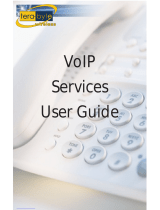
R38-300/310 v1.8 TelNet OfficeEdge Complete Reference Guide | 4 |
Contacts and Favorites (Speed Dial Keys)
Contact Directory
To view your directory
1) Select Directories from Home View. Contact Directory is
highlighted, then press Select.
To add a contact
1) Navigate to your Contact Directory and press Add.
2) Type the contact’s information, and press Save. The
phone number should be added to the Contact field.
To make a contact a Favorite
1) Enter a Favorite Index number. The phone number should
be added to the Contact field.
To update contact information
1) Navigate to your Contact Directory and select the contact.
2) Press Info, press Edit, update the contact’s information,
and press Save.
To delete a contact
1) Navigate to your Contact Directory and select the contact.
2) Press Info, press More, Delete, and press Yes to confirm.
To search for a contact
1) Navigate to your Contact Directory and press Search.
2) Enter search criteria, and press Search.
To dial a contact from your directory
1) Navigate to your Contact Directory and select the contact.
2) Press Dial.
Tip: What Does a Green Star Mean?
A green star, , indicates a Favorite (Your top
ranked Favorites appear as Speed Dial Keys).
Favorites (Speed Dial Keys)
Favorites are contacts you call most often. Favorites display in
your Favorites list and Lines view as Speed Dial Keys. They also
display when you press the phone line in Home view. (Note
that the display of Favorites may be lost after a phone reboot.)
To view your Favorites list
1) From Home View, select Directories and then Favorites.
To make a contact a Favorite
1) Navigate to your Contact Directory and press the contact.
2) Press Info, Edit.
3) Enter a number in the Favorite Index (enter 1, 2, etc.)
4) Press Save.
To speed dial a Favorite
1) Press the Favorite (Speed Dial Key) from Lines View or
your Favorites list.
To reorder your favorites list
Update the contact’s Favorite Index number in the
Contact Directory.
Notes
Monitored Lines (BLF Keys) are part of an optional add-
on, and are managed by your phone system
administrator. Up to 3 can be configured.
Line Appearance Keys (3 standard) can independently
handle live calls. With the add-on up to 6 total Line
Appearance Keys can be configured (3 standard, 3
additional). These are also managed by your phone
system administrator.
Speed Dial Keys: Your Favorites can be added and
changed on your phone by designating personal directory
entries as Favorites and then by ranking them. Your top
ranked favorites are displayed as speed dial keys. These
can be added up to the VVX300/310 set’s limit of 6 total
line keys; speed dial keys are displayed where line keys
are not being used by BLF Keys or Line Appearance Keys.
ACD Call Queues (If Enabled)
To log into a Call Queue
1) Press More, and More then press ASignIn. When you are
signed into a call queue, a green icon will be displayed
next to your line.
To log out of a Call Queue
1) Press More, More, More and then press ASignOut. After
logging out, a white icon will be displayed next to your
line.
To change your agent state to unavailable while logged in
1) Press More, More, More and then Unavailable.
2) Press the status that best describes the reason for not
being available (e.g., out to lunch, in a meeting, etc.).
Additional Phone Features
Muting the Microphone
During a call, press (Mute button) so other parties
can’t hear you.
To disable Mute, press again.
Do Not Disturb
To disable ringing, press DND. The LCD display will show a
DND icon and any incoming calls will be directed to
voicemail.
Press DND again to re-enable ringing.








